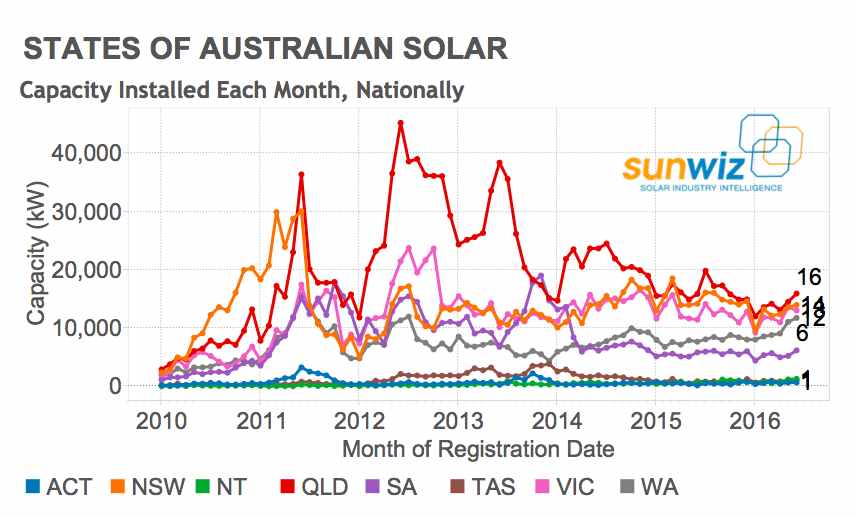The amount of rooftop solar installed across Australia is expected to break through the 5GW mark in July, reaching a remarkable milestone in a sector that was virtually non-existent in 2009.
New data released by solar statistician and consultancy Sunwiz shows that 64MW of rooftop solar was added across the country in the month of June, taking the national cumulative total to 4.964GW. At current rates of installation, the 5GW threshold should be broken in the next week or two.

The Australian solar market has slowed down considerably since its peak in 2012 and 2013, at the height of premium feed in solar tariffs offered by the states.
But the market is still growing at around 700MW-800MW a year, and is expected to accelerate as more houses consider battery storage, particularly with a new surge in electricity bills caused by the surging price of gas and gas-fired generation.

The state with the most solar capacity remains Queensland, which is now at 1.534GW, followed by NSW (1.07GW) and Victoria (935MW). Rooftop solar is now thought to account for around 3 per cent of total consumption in Australia.
A recent report suggested that more than 1.5 million Australian households and businesses have invested more than $8 billion in rooftop solar (net of subsidies), and are saving around $1 billion a year on their electricity bills.
“5GW of rooftop solar demonstrate how much the people of Australia love solar, and what’s more they prefer generating their own power than buying it from a coal fired power station,” says Warwick Johnston, the director of Sunwiz.
Forecasts vary for the future growth of rooftop solar PV, but one of the most authoritative comes from Bloomberg New Energy Finance, which predicts 38GW of rooftop solar by 2040. (See Australia’s big energy switch from coal and gas to wind and solar).
Solar investor and financier Lighthouse Infrastructure, however, predicts 52GW of solar by the same year, although this includes large scale installations. (See Australia to get 52GW of solar capacity in dramatic energy transformation).
Sunwiz says one of the most interesting aspects of the market in the latest month is the growing share of commercial-scale rooftop solar (on the rooftops of businesses), which now accounts for 30 per cent of the market. This is seen by many as the biggest untapped market sector in Australia.
Another interesting trend is the growing reach of the major utilities such as AGL Energy and Origin Energy, whose efforts to recapture a share of the rooftop solar installation market are paying dividends, although they continue to trail the largest installation companies.











